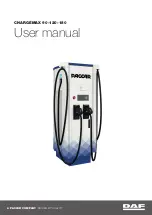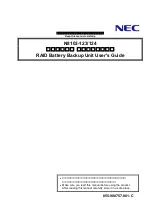
4
5
l
CONNECTING TO BATTERIES OUT OF THE VEHICLE:
Connect the crocodile clips to the battery in the following order:
1. Connect positive charging lead (red) to the positive post of the battery (marked P or +).
2. Connect the negative lead (black) to the negative post of the battery (marked N or -). It is important
that the crocodile clips make good contact with the battery terminals. If necessary use a small wire
brush to clean the terminals.
NOTE: A marine (boat) battery must be removed and charged on land (shore).
CHARGING:
WARNING!
l
DO NOT attempt to start a vehicle whilst connected to the charger as this will
cause damage.
l
DO NOT attempt to charge a frozen battery.
1.
Connect the crocodile clips to the battery. (See ‘CONNECTION’ in ‘OPERATING INSTRUCTIONS’).
2.
Plug the charger into the mains power. The ‘Power’ LED will illuminate and the ‘12V’ and ‘6V’ LEDs
will begin to flash.
3.
Press the ‘STEP 1’ button to select the voltage of the battery you wish to charge.
4.
Next, press the ‘STEP 2’ button to select the type of battery you wish to charge. If unsure, please
contact the manufacturer or retailer.
5.
Press the ‘STEP 3’ button to select the charging rate. Please refer to the following table:
NOTE: For all 6V batteries, the charger gives a 7.5V constant voltage charge.
6.
Once the charging rate is selected, the ‘READY’ LED should be illuminated. Press ‘GO’ to
begin charging.
OPERATING INSTRUCTIONS
BATTERY PREPARATION:
CAUTION!
l
Ensure you wear appropriate personal protection including safety goggles as some
electrolyte spillage may occur during the following procedures. It is advised before
charging to remove the battery from the vehicle to prevent damage to sensitive on
board equipment on your vehicle.
l
Before removing or replacing your battery ensure you read the vehicle handbook and care
fully follow the instructions relating to battery removal and fitting.
1.
Determine voltage of battery by referring to car owners manual.
2.
If it is necessary to remove battery from vehicle to charge, or to clean terminals, always remove
grounded terminal from battery first. Make sure all accessories in the vehicle are off, so as not to
cause an arc.
3.
Clean battery terminals. Be careful to keep corrosion from coming in contact with eyes.
4.
If the battery is not a sealed unit, remove the filler caps and check the level of the electrolyte. If it is
below the manufacturers recommended level, top up using distilled water.
DO NOT
use tap water
under any circumstances.
5.
To prevent acid splashing during the charging process, replace the filler caps but do not tighten them
to allow gasses to escape.
6.
If the battery is a sealed unit it is unnecessary to carry out these checks.
7.
Study all battery manufacturers specific precautions such as removing or not removing cell caps while
charging and recommended rates of charge.
8.
Ensure the area around battery is well ventilated while battery is being charged.
9.
Make sure the initial charging rate does not exceed the battery manufacturers suggestion.
CONNECTION:
WARNING!
l
To avoid sparks which could cause an explosion, ensure charger is disconnected from
the mains supply before making or breaking connection.
l
CONNECTING TO BATTERIES IN VEHICLES:
1.
Position the connection leads away from the bonnet, doors and moving engine parts to reduce the risk
of damage.
2.
Stay clear of fan blades, belts, pulleys and any other parts that can cause personal injury.
3.
Determine which post (positive or negative) of the battery is grounded (connected) to the chassis.
- If the negative post is grounded to the chassis (as in most vehicles):
1. Connect the positive charging lead (red) to the positive post of the battery (marked P or +).
2. Connect the negative charging lead (black) to the chassis of the vehicle.
- If the positive post is grounded to the chassis:
1. Connect the negative charging lead (black) to the negative post of the battery (marked N or -).
2. Connect the positive charging lead (red) to the chassis of the vehicle.
WARNING!
l
Do not connect leads to the fuel lines, carburettor, or any sheet metal parts
of the body.
12V Battery
1A
4A
GEL
0-40Ah
40-200Ah
AGM
0-20Ah
20-200Ah
WET
0-20Ah
20-200Ah
KEN-503-0320K_INSTRUCTIONS_Layout 1 16/11/2012 14:48 Page 4






















